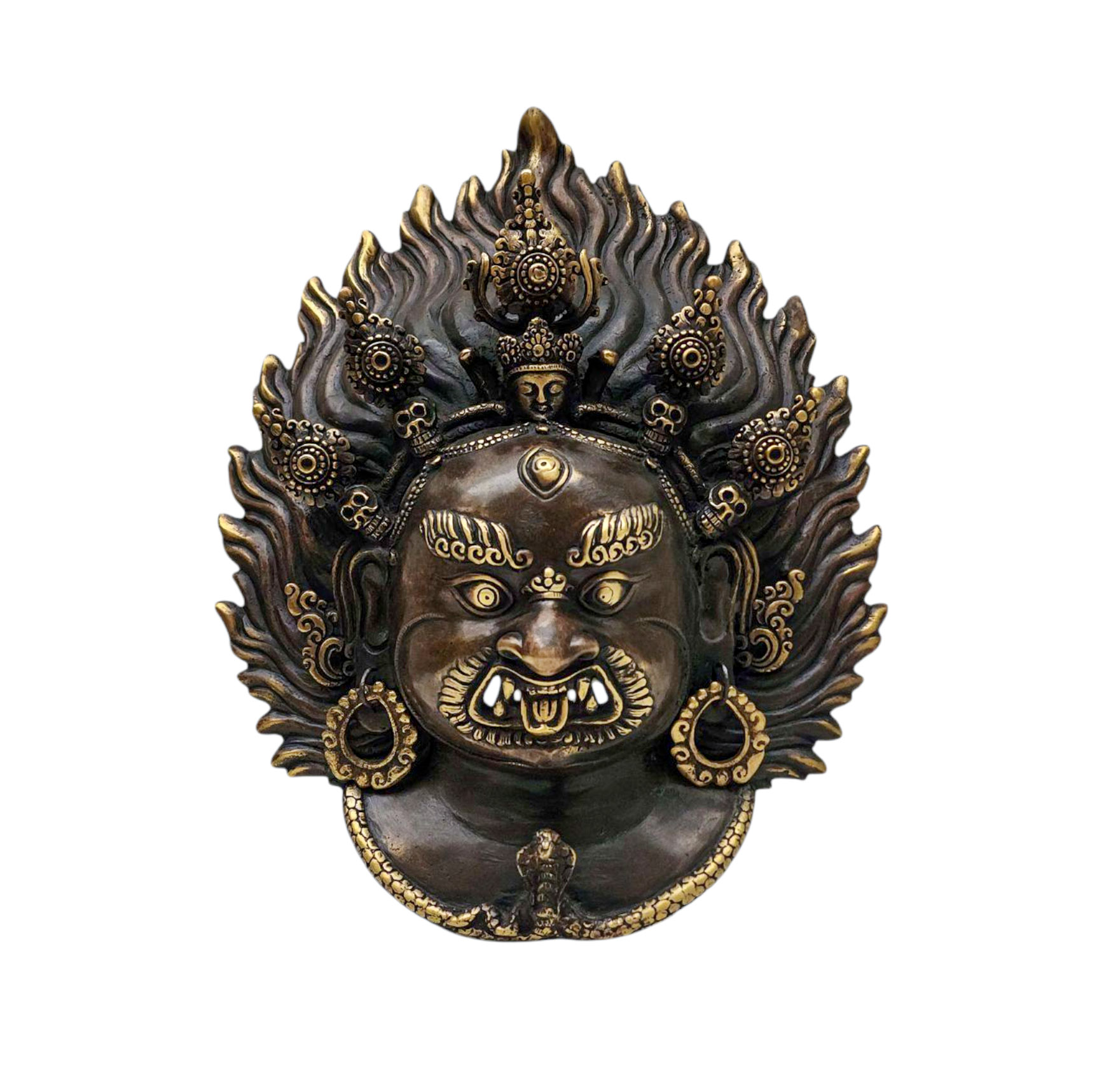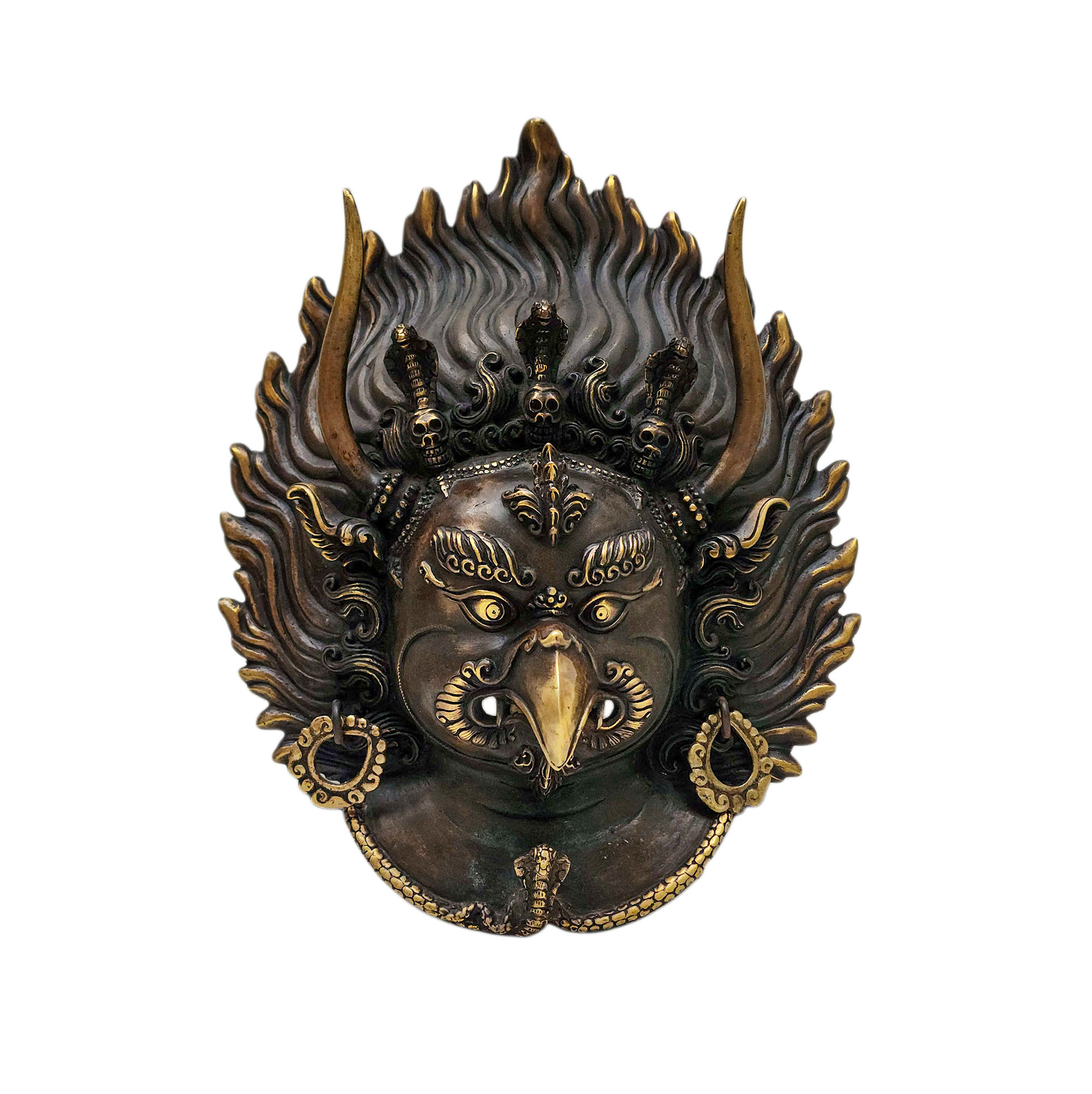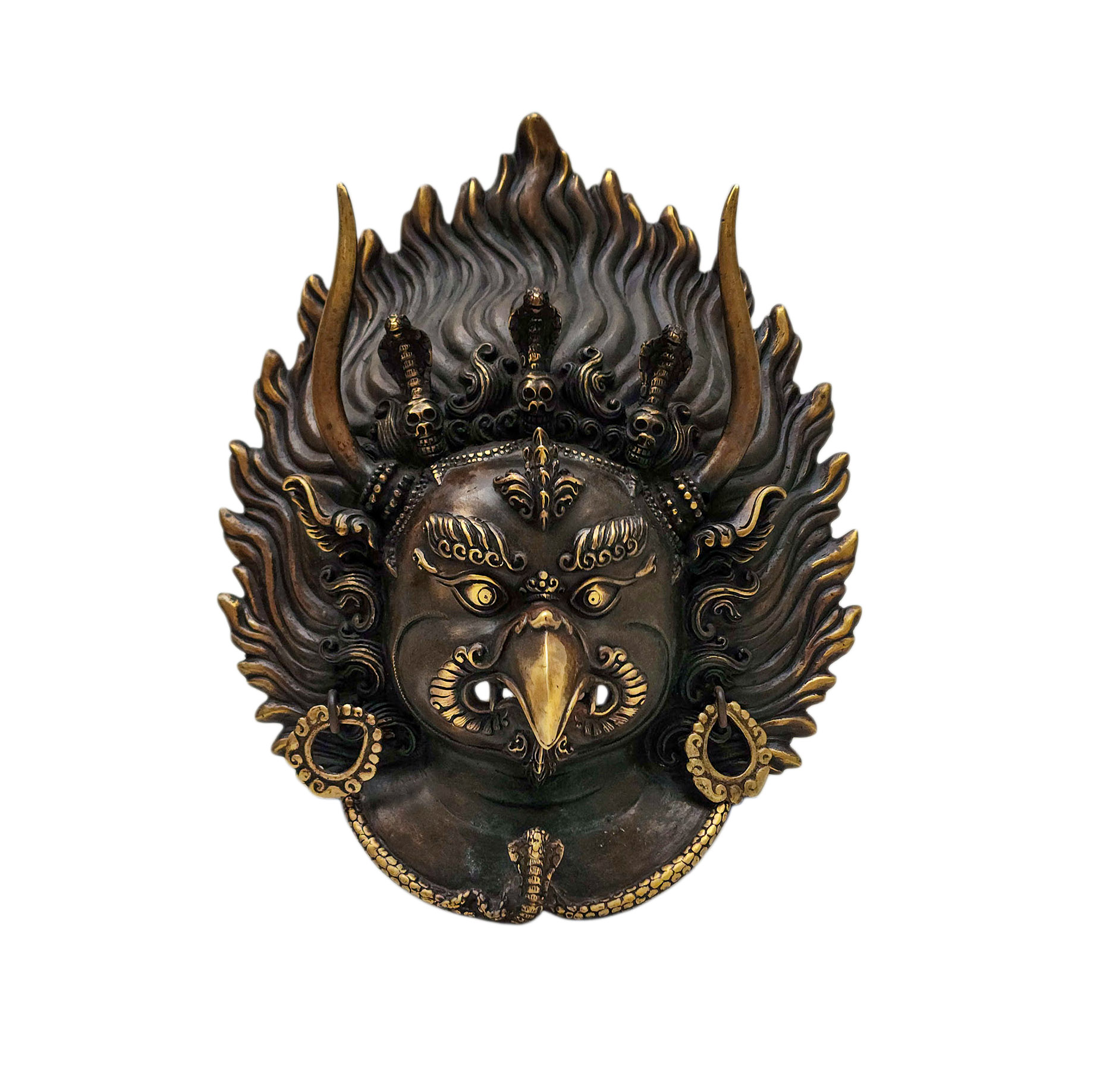Code
HCS35040
Weight
1.15 Kg / 2.54 lbs
Size
Height
27cm (11") Width
21cm (8") Depth
8cm (3") Material
Brass
Availability
Available

Safe Payment
We accept Paypal, Money Transfer, Bank Transfer
Confidence
Protection covers your purchase and personal data.
Worldwide Delivery
We ship Worldwide, except Russia.Shipping cost US$25.2 for upto 0.5 kgs

Hotline
Talk to help line for your question on 9841267335Lost-Wax System
This Metal Mask of [bhairav], Handmade Ritual Metal Mask, Antique Finishing, Mahakala, Aakash Bhairav is made by the process of the Lost Wax system. This is a very complicated, time consuming and historic process of making metal sculptures.Which is why it is sometimes called Precision Casting as well. Hence the sculptures made by this process are comparatively expensive. There are many new, advanced and less time consuming methods of casting metal sculptures available as well. But due to the benefits provided by the traditional lost wax system in quality control and customization, we prefer the Loss wax system over Ceramic molding, or sand casting to make our Metal Mask.
Below we have tried to illustrate the process of making a loss wax system statue: Read More . . .
This Metal Mask of [bhairav], Handmade Ritual Metal Mask, Antique Finishing, Mahakala, Aakash Bhairav is made by the process of the Lost Wax system. This is a very complicated, time consuming and historic process of making metal sculptures.Which is why it is sometimes called Precision Casting as well. Hence the sculptures made by this process are comparatively expensive. There are many new, advanced and less time consuming methods of casting metal sculptures available as well. But due to the benefits provided by the traditional lost wax system in quality control and customization, we prefer the Loss wax system over Ceramic molding, or sand casting to make our Metal Mask.
Below we have tried to illustrate the process of making a loss wax system statue: Read More . . .
Metal Wall Hangings : Brief Introduction
Tibetan Buddhist culture is rich in symbolism and art, and metal or wooden wall hangings are essential to this tradition. These wall hangings, also known as paubhas, are typically made in painting form, painted on a cotton canvas with natural color. they are also made in wood, brass, or clay, and feature intricate designs and vibrant colors. They depict various aspects of Buddhism, such as deities, Buddhist teachings, and spiritual stories. Many of these wall hangings are adorned with semi-precious stones, such as turquoise, coral, and lapis lazuli, which add to their beauty and symbolic significance. Read More . . .
Tibetan Buddhist culture is rich in symbolism and art, and metal or wooden wall hangings are essential to this tradition. These wall hangings, also known as paubhas, are typically made in painting form, painted on a cotton canvas with natural color. they are also made in wood, brass, or clay, and feature intricate designs and vibrant colors. They depict various aspects of Buddhism, such as deities, Buddhist teachings, and spiritual stories. Many of these wall hangings are adorned with semi-precious stones, such as turquoise, coral, and lapis lazuli, which add to their beauty and symbolic significance. Read More . . .
Brief Introduction :
Akash Bhairav is a Hindu deity. Considered the "god of the sky", several large temples in Kathmandu are dedicated to him.
The head of the Aakash Bhairav was dug up several hundred years ago in Kathmandu. The head now resides in a Hindu temple in Kathmandu not far from Durbar Square and is taken out of the temple once a year and is blessed by the Kumari - the living goddess who lives in the nearby Kumari Chowk. He is also known as King Yalamber of Kirat, Aju dya for Newars, and Barbarik, grandson of Bhimsen, In the common Kathmandu myth he is the god who will always fight for the weak or the losing side. Hence he is one of the beloved gods of the people of Kathmandu and is considered as the ancestor god of the people of Kathmandu.
The head of the Aakash Bhairav was dug up several hundred years ago in Kathmandu. The head now resides in a Hindu temple in Kathmandu not far from Durbar Square and is taken out of the temple once a year and is blessed by the Kumari - the living goddess who lives in the nearby Kumari Chowk. He is also known as King Yalamber of Kirat, Aju dya for Newars, and Barbarik, grandson of Bhimsen, In the common Kathmandu myth he is the god who will always fight for the weak or the losing side. Hence he is one of the beloved gods of the people of Kathmandu and is considered as the ancestor god of the people of Kathmandu.
In September of 2007 Nepal's state-run airline confirmed that it had sacrificed two goats to appease Akash Bhairab, whose symbol is seen on the company's planes, following technical problems with one of its aircraft. Nepal Airlines said the animals were slaughtered in front of the plane - a Boeing 757 - at Kathmandu airport. . The airline said that after the ceremony the plane successfully completed a flight to Hong Kong. "The snag in the plane has now been fixed and the aircraft has resumed its flights," senior airline official Raju KC was quoted as saying. The company did not say what the problem was, but reports in local media had blamed an electrical fault.


![[bhairav], Handmade Ritual Metal Mask, Antique Finishing, Mahakala, Aakash Bhairav](https://handmadeexpo.com/pics/product/thumb/35040.jpg)
![[bhairav], Handmade Ritual Metal Mask, Antique Finishing, Mahakala, Aakash Bhairav](https://www.handmadeexpo.com/pics/product/thumb/35040_0.jpg)
![[bhairav], Handmade Ritual Metal Mask, Antique Finishing, Mahakala, Aakash Bhairav](https://www.handmadeexpo.com/pics/product/thumb/35040_1.jpg)
![[bhairav], Handmade Ritual Metal Mask, Antique Finishing, Mahakala, Aakash Bhairav](https://www.handmadeexpo.com/pics/product/thumb/35040_2.jpg)
![[bhairav], Handmade Ritual Metal Mask, Antique Finishing, Mahakala, Aakash Bhairav](https://www.handmadeexpo.com/pics/product/thumb/35040_3.jpg)




























































 Bhairav, Handmade Ritual Metal Mask, Antique Finishing, Mahakala, Aakash Bhairav" title="
Bhairav, Handmade Ritual Metal Mask, Antique Finishing, Mahakala, Aakash Bhairav" title=" Bhairav, Handmade Ritual Metal Mask, Antique Finishing, Mahakala, Aakash Bhairav" title="
Bhairav, Handmade Ritual Metal Mask, Antique Finishing, Mahakala, Aakash Bhairav" title="

 Garuda, Handmade Ritual Metal Mask, Antique Finishing" title="
Garuda, Handmade Ritual Metal Mask, Antique Finishing" title=" Garuda, Handmade Ritual Metal Mask, Antique Finishing" title="
Garuda, Handmade Ritual Metal Mask, Antique Finishing" title="



 Glossy,
Glossy,  Glossy,
Glossy, 



 Sand Casting" title="Ganesh Metal Mask
Sand Casting" title="Ganesh Metal Mask  Sand Casting" title="Ganesh Metal Mask
Sand Casting" title="Ganesh Metal Mask